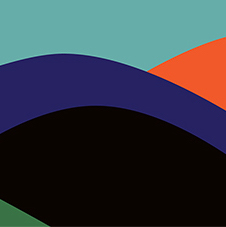Up a lattice of sumac and into the spars
of the elderberry, the first pumpkin vine had climbed,
and a week after first frost
great pendulous melons dangled like gods
among the bunches of lesser berries
and the dazzled, half-drunken birds.
Then the pumpkins fell, each mythical fruit’s
dried umbilicus giving way in a rush
of gold and snow of elliptical leaves.
A skull thud, the dull thunk of rupture,
a thin smoke then, like a soul, like dust.
But the last, high up and lodged
in a palm of limbs and pithy branches,
sways now in the slightest breeze and freeze
after freeze caves in on itself
and will, by spring, cast its black
leathery gaze out over the garden
like the mummy of a saint or an infirm
and desiccated pope. Below, where the others fell,
that seed not eaten by winter birds,
one, say, buried in meat and a sheath
of skin, will rise. From its blunt,
translucent nubbin, a leaf trifoliate
and a stalk as succulent as bamboo, it will climb
blithe as a baby Christ up the knees
of the wood it cannot know it is bound for.
Born in Illinois in 1951, Robert Wrigley earned his MFA from the University of Montana. Many of his poems illustrate mankind’s relationship with the natural world. Robert Wrigley’s books include Earthly Meditations (Penguin, 2006) Beautiful Country (Penguin, 2010) and Anatomy of Melancholy and Other Poems, (Penguin, 2013). His awards include a Guggenheim Foundation Fellowship and the Kingsley Tufts Award. He teaches in the MFA program at the University of Idaho.
In his poem, Wrigley instills religious significance in the lifespan of a pumpkin. Throughout the poem, which is comprised of four quintains and one sestet, Wrigley describes the growth of a pumpkin with religious allusion. The poem begins with the vine’s ascension of the lattice after the “first frost” (3). This use of alliteration highlights the biting nature of nature’s frost and ice from which the pumpkin emerges. The first indication of the religious nature of the poem is in line four: “great pendulous melons dangled like gods.” Wrigley’s description gives the pumpkins a sense of omniscience, height, and godliness; he specifically deifies them. The second stanza describes their fall as a birth: “then the pumpkins fell, each mythical fruit’s/dried umbilicus giving way in a rush/of gold and snow of elliptical leaves” (7-9). Wrigley then transitions to the last pumpkin that remains in the air; using internal rhyme he describes that it “sways now in the slightest breeze and freeze” (14). Although the pumpkin will die as the colder months set in, it “will, by spring, cast its black/leathery gaze out over the garden/ like the mummy of a saint or an infirm/and desiccated pope” (16-19). Like a dead, withered pope or the preserved corpse of a saint, the pumpkin will linger and will be reborn, only to fall once again. Comparing the pumpkin to major religious figures, Wrigley inscribes a sense of spiritual, otherworldly significance, relating the physical plant to a higher power. As the new pumpkin grows from where others have fallen, “it will climb/blithe as a baby Christ up the knees/ of the wood it cannot know it is bound for” (24-26). Wrigley links the wooden lattice to the cross on which Jesus was crucified. Because the pumpkin is newly born, it has no understanding that it is predestined to face the same crucifixion and death. Wrigley links these strong religious themes, including images of the crucifixion and deceased spiritual icons, in order to deify the pumpkin’s life and death.
